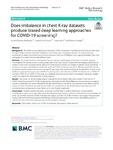Mostrar o rexistro simple do ítem
Does imbalance in chest X-ray datasets produce biased deep learning approaches for COVID-19 screening?
| dc.contributor.author | Álvarez-Rodríguez, Lorena | |
| dc.contributor.author | Moura, Joaquim de | |
| dc.contributor.author | Novo Buján, Jorge | |
| dc.contributor.author | Ortega Hortas, Marcos | |
| dc.date.accessioned | 2022-07-14T16:44:50Z | |
| dc.date.available | 2022-07-14T16:44:50Z | |
| dc.date.issued | 2022 | |
| dc.identifier.citation | Álvarez-Rodríguez, L., Moura, J.d., Novo, J. et al. Does imbalance in chest X-ray datasets produce biased deep learning approaches for COVID-19 screening?. BMC Med Res Methodol 22, 125 (2022). https://doi.org/10.1186/s12874-022-01578-w | es_ES |
| dc.identifier.uri | http://hdl.handle.net/2183/31184 | |
| dc.description.abstract | [Abstract] Background The health crisis resulting from the global COVID-19 pandemic highlighted more than ever the need for rapid, reliable and safe methods of diagnosis and monitoring of respiratory diseases. To study pulmonary involvement in detail, one of the most common resources is the use of different lung imaging modalities (like chest radiography) to explore the possible affected areas. Methods The study of patient characteristics like sex and age in pathologies of this type is crucial for gaining knowledge of the disease and for avoiding biases due to the clear scarcity of data when developing representative systems. In this work, we performed an analysis of these factors in chest X-ray images to identify biases. Specifically, 11 imbalance scenarios were defined with female and male COVID-19 patients present in different proportions for the sex analysis, and 6 scenarios where only one specific age range was used for training for the age factor. In each study, 3 different approaches for automatic COVID-19 screening were used: Normal vs COVID-19, Pneumonia vs COVID-19 and Non-COVID-19 vs COVID-19. The study was validated using two public chest X-ray datasets, allowing a reliable analysis to support the clinical decision-making process. Results The results for the sex-related analysis indicate this factor slightly affects the system in the Normal VS COVID-19 and Pneumonia VS COVID-19 approaches, although the identified differences are not relevant enough to worsen considerably the system. Regarding the age-related analysis, this factor was observed to be influencing the system in a more consistent way than the sex factor, as it was present in all considered scenarios. However, this worsening does not represent a major factor, as it is not of great magnitude. Conclusions Multiple studies have been conducted in other fields in order to determine if certain patient characteristics such as sex or age influenced these deep learning systems. However, to the best of our knowledge, this study has not been done for COVID-19 despite the urgency and lack of COVID-19 chest x-ray images. The presented results evidenced that the proposed methodology and tested approaches allow a robust and reliable analysis to support the clinical decision-making process in this pandemic scenario. | es_ES |
| dc.description.sponsorship | This research was funded by Instituto de Salud Carlos III, Government of Spain, DTS18/00136 research project; Ministerio de Ciencia e Innovación y Universidades, Government of Spain, RTI2018-095894-B-I00 research project; Ministerio de Ciencia e Innovación, Government of Spain through the research project with reference PID2019-108435RB-I00; Consellería de Cultura, Educación e Universidade, Xunta de Galicia, Grupos de Referencia Competitiva, grant ref. ED431C 2020/24; postdoctoral grant ref. ED481B 2021/059; Axencia Galega de Innovación (GAIN), Xunta de Galicia, grant ref. IN845D 2020/38; CITIC, Centro de Investigación de Galicia ref. ED431G 2019/01, receives financial support from Consellería de Educación, Universidade e Formación Profesional, Xunta de Galicia, through the ERDF (80%) and Secretaría Xeral de Universidades (20%) | es_ES |
| dc.description.sponsorship | Xunta de Galicia; ED431C 2020/24 | es_ES |
| dc.description.sponsorship | Xunta de Galicia; ED481B 2021/059 | es_ES |
| dc.description.sponsorship | Xunta de Galicia; IN845D 2020/38 | es_ES |
| dc.description.sponsorship | Xunta de Galicia; ED431G 2019/01 | es_ES |
| dc.language.iso | eng | es_ES |
| dc.publisher | BMC | es_ES |
| dc.relation.uri | https://doi.org/10.1186/s12874-022-01578-w | es_ES |
| dc.rights | Atribución 3.0 España | es_ES |
| dc.rights.uri | http://creativecommons.org/licenses/by/3.0/es/ | * |
| dc.subject | CAD system | es_ES |
| dc.subject | Chest X-ray | es_ES |
| dc.subject | COVID-19 screening | es_ES |
| dc.subject | Data analysis | es_ES |
| dc.subject | Deep learning | es_ES |
| dc.title | Does imbalance in chest X-ray datasets produce biased deep learning approaches for COVID-19 screening? | es_ES |
| dc.type | info:eu-repo/semantics/article | es_ES |
| dc.rights.access | info:eu-repo/semantics/openAccess | es_ES |
| UDC.journalTitle | BMC Medical Research Methodology | es_ES |
| UDC.volume | 22 | es_ES |
| UDC.startPage | 125 | es_ES |
| dc.identifier.doi | 10.1186/s12874-022-01578-w |
Ficheiros no ítem
Este ítem aparece na(s) seguinte(s) colección(s)
-
GI-VARPA - Artigos [75]






